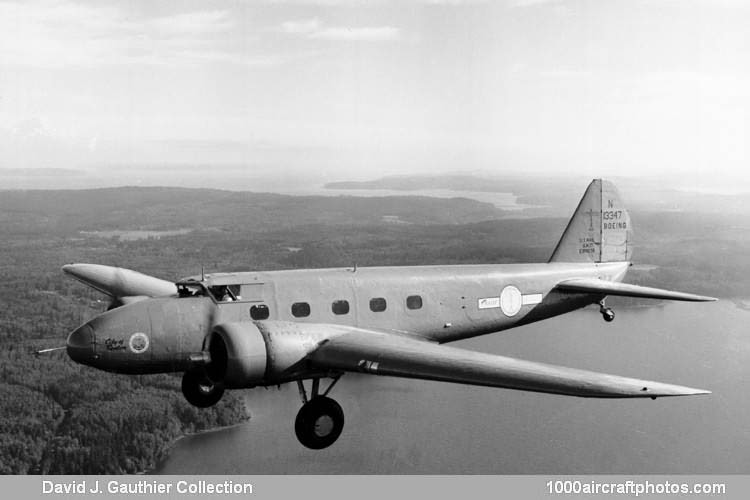12/31/2009. Remarks by Johan Visschedijk: "The 247 was a twin-engine transport incorporating the structural and aerodynamic features of the Monomail and the B-9, and like them, it revolutionized aircraft design in its particular field. However, unlike its two predecessors, the 247 earned Boeing a return on its pioneering effort in the transport field by winning large production orders.
The 247 was slightly smaller and lighter than the Ford, Fokker and Boeing Trimotors that it was to replace, but it was 50 to 70 mph (80 to 113 kmh) faster and could climb with one engine dead while carrying a full load. It was the first low-wing multi-engine American transport, with a configuration well suited to clean aerodynamic design but which offered a slight disadvantage from the passenger standpoint in that the main wing spars passed right through the ten-passenger cabin.
A total of 70 Boeing 247s was ordered by the various airlines that comprised United Air Lines (UAL) in 1932, and 59 of the first 60 were completed for UAL as Model 247 under TC 500, registered NC13301 to NC13359 c/n 1682 to 1710, 1712 to 1741. The remainder were completed as Model 247D, and all of the plain 247s remaining in service with UAL through 1935 were converted to 247Ds.
The last two 247s for a total of 61 were shipped to Luft Hansa in Germany (registered D-AGAR and D-AKIN c/n 1944 and 1945) after being assigned temporary US registration numbers (NC90Y and NC91Y) separate from the rest of the 247 series. The first 247 flew on February 8,1933, and while it was a production aircraft, it served as the test article for certification of the series.
The original color scheme of the 247s was all grey, and resulted from the anodized finish of the dural skin rather than from paint. Slightly different shades from different batches of metal gave some of the aircraft a patched look. This was overcome in 1940 when UAL painted its 247 fleet white with blue trim.
Produced as a Model 247, NC13347 was delivered to Pacific Air Transport on July 26, 1933, nine months later, May 1, 1934, the plane was folded into the new UAL, and flew until mid-1935 when it was upgraded to 247D standards. It returned to service on August 27, 1935, till it was sold to Pennsylvania Central Airlines, serving only a few years with the airline, as in 1940 it was acquired by the Canadian Department of Munitions, registered as CF-BTD. Soon it was transferred to the RCAF with s/n 7839.
However, after just over a year with the RCAF it was struck off charge on December 17, 1941 and sold to Maritime Central Airways, again registered as CF-BTB. In 1945 it returned to the USA, again registered NC13347 it served with Columbia Airlines. In June 1951, the aircraft was sold to Aerovias Occidentales of San Jose, Costa Rica, registered as TI-1011, it flew for a brief period as it was damaged on January 3, 1952.
After two years of repairs it was transferred to the USA, registered as N3977C to Marsh Aircraft of Hollywood, Florida in December 1954, and was used for crop spraying, while on October 1, 1956 it was acquired by Precipitation Control of Taft, California, and used to seed clouds in order to create rain. However, by 1961 it was derelict at the small Taft airport, eventually it was acquired by the Pacific Northwest Aviation Historical Foundation (PNAHF, now known as the Museum of Flight) in 1966, registered as N13347.
In late 1979 a long-term restoration was started, many parts were replaced, while the interior was refurbished to the UAL style of the 1930s. The aircraft was flown again on June 29, 1994, and on February 1, 1995 the aircraft received its Standard CofA as a fully certified commercial carrier. Since the aircraft has been shown on many air events and in between is on display at Museum of Flight at Boeing Field."
